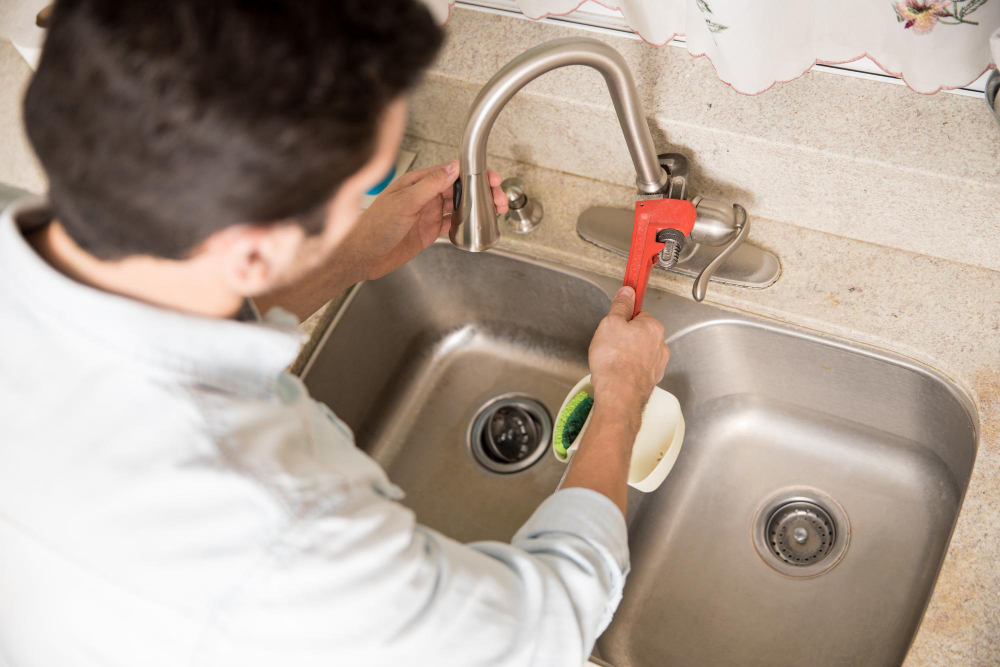We’ve all been there. You’re washing dishes after dinner, and suddenly you notice the water isn’t going down. Instead, it’s pooling in your sink, creating that dreaded standing water situation. Before you reach for the phone to call a plumber (and prepare to shell out $100+ for a house call), try these DIY methods to get your kitchen sink flowing freely again.
Why Kitchen Sinks Clog
Kitchen sinks are particularly prone to clogs because of what goes down them daily:
- Food particles
- Grease and cooking oils
- Coffee grounds
- Soap scum
- Small objects accidentally dropped in
Even with a garbage disposal, these items can build up over time and cause blockages in your pipes. The good news? Most kitchen sink clogs are easily fixable without professional help.
Tools You’ll Need
Before diving into unclogging methods, gather these basic supplies:
- Rubber gloves
- Bucket or large bowl
- Plunger (preferably a flat-bottomed sink plunger)
- Baking soda
- Vinegar
- Boiling water
- Plumber’s snake or drain auger (optional)
- Old toothbrush (for cleaning the P-trap)
Most of these items are probably already in your home, making these fixes truly budget-friendly.
7 DIY Methods to Unclog Your Kitchen Sink
1. Boiling Water Flush
Difficulty level: Easy
The simplest fix is often the most effective. For minor clogs caused by grease buildup:
- Boil a full kettle of water
- Pour the boiling water down the drain in three stages, allowing each pour to work for a few seconds
- Run the faucet to check if the drain is flowing freely
This method works by melting away grease that’s congealed in your pipes. It’s perfect for minor clogs and regular maintenance.
Pro tip: Never pour boiling water down drains connected to PVC pipes, as it can loosen joints and cause damage. If you have PVC pipes, use hot (not boiling) tap water instead.
2. The Plunger Method
Difficulty level: Easy
When standing water won’t go down, a plunger should be your next step:
- If you have a double sink, seal off the second drain with a wet cloth or stopper
- Fill the clogged sink with enough water to cover the plunger’s rubber bell
- Place the plunger over the drain and ensure a tight seal
- Plunge vigorously for 20-30 seconds with quick up and down motions
- Check if the water drains
The suction created by plunging can dislodge many clogs effectively. For best results, use a flat-bottomed sink plunger rather than a toilet plunger.
3. Baking Soda and Vinegar Magic
Difficulty level: Easy
This chemical reaction helps break down organic matter and is much safer than commercial drain cleaners:
- Remove standing water from the sink (scoop it out into a bucket)
- Pour 1 cup of baking soda down the drain
- Follow with 1 cup of white vinegar
- Immediately cover the drain with a stopper or plate to contain the fizzing action
- Wait 15-30 minutes
- Flush with hot water
The bubbling reaction helps loosen debris and break down grease. This method is also great for eliminating drain odors.
4. Salt and Baking Soda Mix
Difficulty level: Easy
For stubborn clogs:
- Mix 1/2 cup salt with 1/2 cup baking soda
- Pour the mixture down the drain
- Let it sit for 10-20 minutes
- Flush with boiling water
The abrasive nature of salt combined with baking soda’s cleaning properties can tackle tougher buildup.
5. Clean the P-Trap
Difficulty level: Moderate
If the clog persists, it might be in the P-trap—that curved pipe section under your sink:
- Place a bucket beneath the P-trap to catch water
- Unscrew the connectors on both ends of the P-trap (usually hand-tight, but you might need pliers)
- Remove the P-trap and clear any debris
- Check for clogs in the exposed pipes using a straightened coat hanger or flashlight
- Rinse the P-trap with water
- Reattach the P-trap and tighten the connectors
This hands-on method allows you to physically remove blockages and inspect your pipes.
6. Use a Plumber’s Snake
Difficulty level: Moderate
For clogs beyond the P-trap:
- Insert the snake into the drain or through the pipe where you removed the P-trap
- Turn the handle clockwise as you push it further into the pipe
- When you feel resistance, you’ve likely reached the clog
- Rotate and push the snake to break up the blockage
- Pull out the snake and flush the drain with hot water
A plumber’s snake (also called a drain auger) can reach clogs several feet down your pipes. You can rent one from hardware stores if you don’t want to purchase.
7. Wet/Dry Vacuum
Difficulty level: Moderate
For bizarre clogs or objects:
- Set your wet/dry vacuum to “wet” mode
- Create a tight seal over the drain (you might need to get creative with an adapter)
- Run the vacuum on its highest setting for 1-2 minutes
- Flush with water to check if the clog is gone
This method creates powerful suction that can pull up clogs that pushing methods can’t reach.
Preventing Future Clogs
Once your sink is draining properly again, keep it that way with these preventive measures:
- Install a sink strainer to catch food particles
- Never pour grease or oil down the drain (collect in a jar and throw away when solid)
- Run hot water after each sink use
- Avoid putting coffee grounds, eggshells, and starchy foods down the disposal
- Pour boiling water down the drain weekly as maintenance
- Use the baking soda/vinegar method monthly to keep pipes clear
When to Call a Plumber
While these DIY methods solve most kitchen sink clogs, some situations warrant professional help:
- Multiple drains in your home are clogged simultaneously
- You’ve tried several methods with no improvement
- You hear gurgling or smell sewage
- The clog keeps returning despite preventive measures
- Your home has old pipes that might be damaged or corroded
Wrap-Up
A clogged kitchen sink is frustrating but rarely requires professional intervention. By working through these methods systematically—starting with the simplest and progressing to more involved techniques—you’ll likely restore proper drainage and save yourself a costly plumber visit.
Keep these supplies on hand, and you’ll be prepared to tackle clogs quickly the next time your sink starts draining slowly. Your wallet (and your dishes) will thank you!
Have you successfully unclogged your kitchen sink with one of these methods? Share your experience in the comments below!



